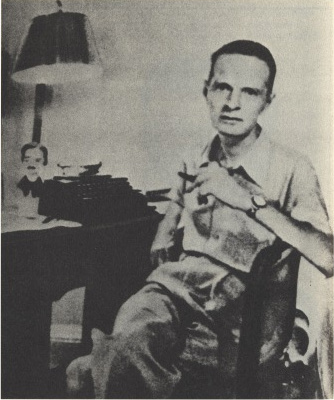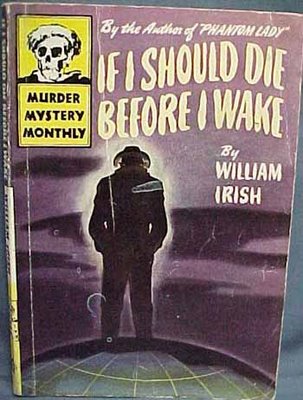
This sickly cove is none other than Cornell George Hopley-Woolrich. Image scanned by Guy Budziak (thanks!) from Francis M Nevins’ First You Dream, Then You Die, the biography of Woolrich.
In his foreword to Nightwebs, an anthology of Woolrich stories, Nevins quotes a passage from I Wake Up Screaming, Steve Fisher’s crime novel, which features a disturbed detective called Cornell ~
“He had red hair and thin white skin and red eyebrows and blue eyes. He looked sick. He looked like a corpse. His clothes didn’t fit him . . . He was frail, gray-faced and bitter. He was possessed with a macabre humor. His voice was nasal. You’d think he was crying. He might have had T.B. He looked like he couldn’t stand up in a wind.”
Interestingly, while Laird Cregar in the movie version of IWUS cannot suggest the character’s slenderness, disbarred as he is by excess poundage, he nails the nasal voice and corpse-like demeanour, accurately suggested a floater fished from the East River.
Woolrich has been compared to Poe, which holds true in some ways and not in others. Poe’s life was disordered, financially fraught, haunted by death. Woolrich was wealthy (he was worth two million when he died), and not adventurous enough to get into real trouble, it seems. His writing suggests a man fearful of any change in routine. But his health was poor, and he seems to have suffered a terror of death since childhood, poisoning his life. One wouldn’t want to be either Poe or Woolrich, but Poe probably had more fun (was a better writer, too).
The true comparison is probably not the alcoholism or misery, but the way both writers devoted the bulk of their work to hammering on a single key, the key of terror. Woolrich can sustain a single note of suspense for an entire novel (as in I Married a Dead Man) and seems to gain power and effectiveness from the speed and even the sloppiness of his writing. Capable of brilliant poetic effects (in the shade of purple), he could blithely toss of clunking nonsense without looking back, but he drags you bodily through the story, over logical crevasses both bottomless and yawning, never relaxing the bony grip on the scruff of your neck or the icy fingers round your heart.

Woolrich wrote for the movies, it appears, around the time of the changeover to sound, and I can talk about that stuff a tiny bit, but really we’re looking at adaptations of his work. This cannot, in one week, be an exhaustive survey of the field, for although, weirdly, there hasn’t been an official Woolrich adaptation since ORIGINAL SIN flopped in 2001, there have been A LOT. I’ve been rooting around amid the more obscure productions, those I can find, but do intend to touch on some of the better-known movies too — PHANTOM LADY, THE LEOPARD MAN, but probably not REAR WINDOW, which I wrote about back in Hitchcock Year.
So don your sailor suits and prepare for the Waltz into Darkness…

UK readers: start here ~
Night and Fear: A Centenary Collection of Stories










